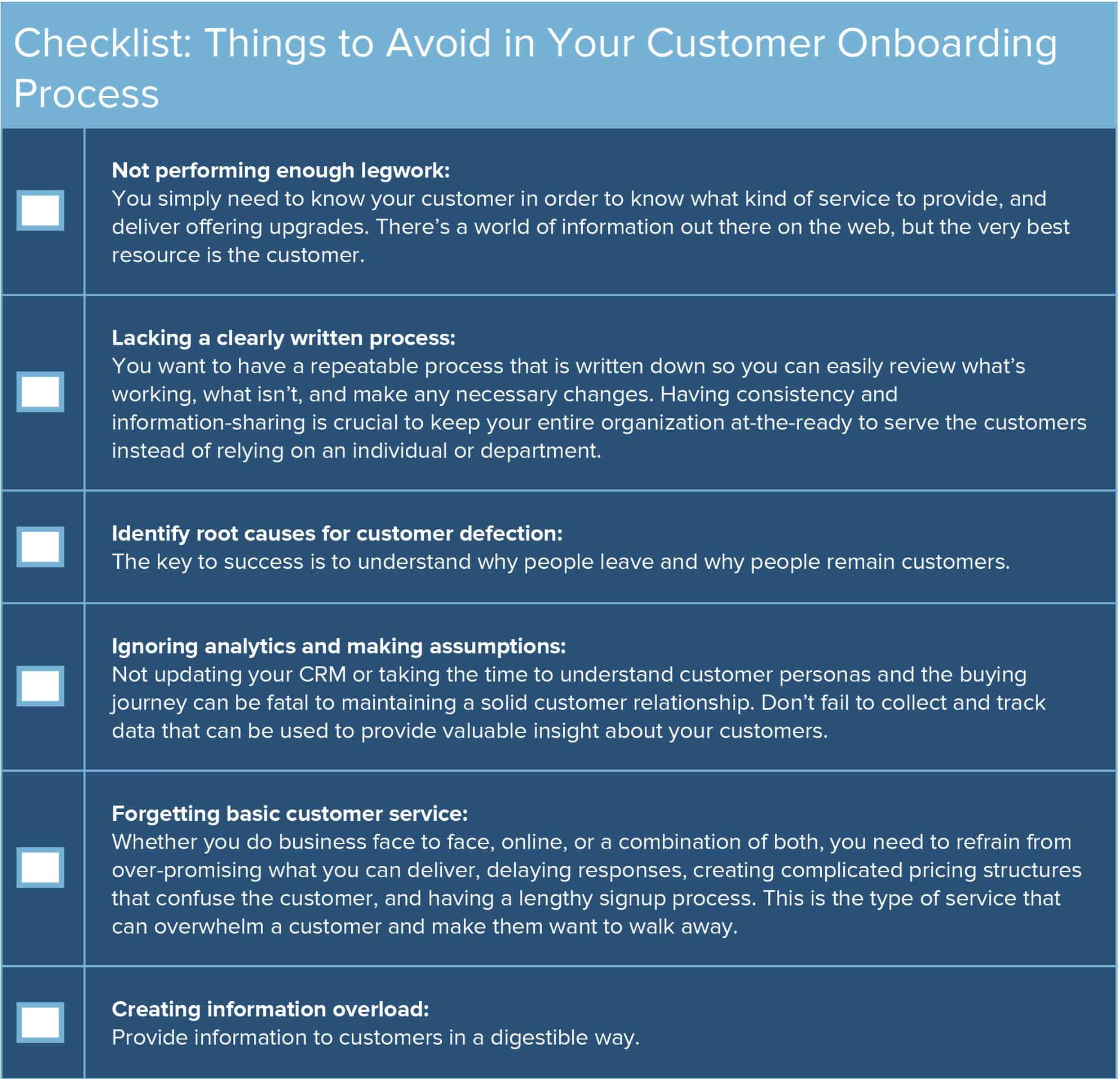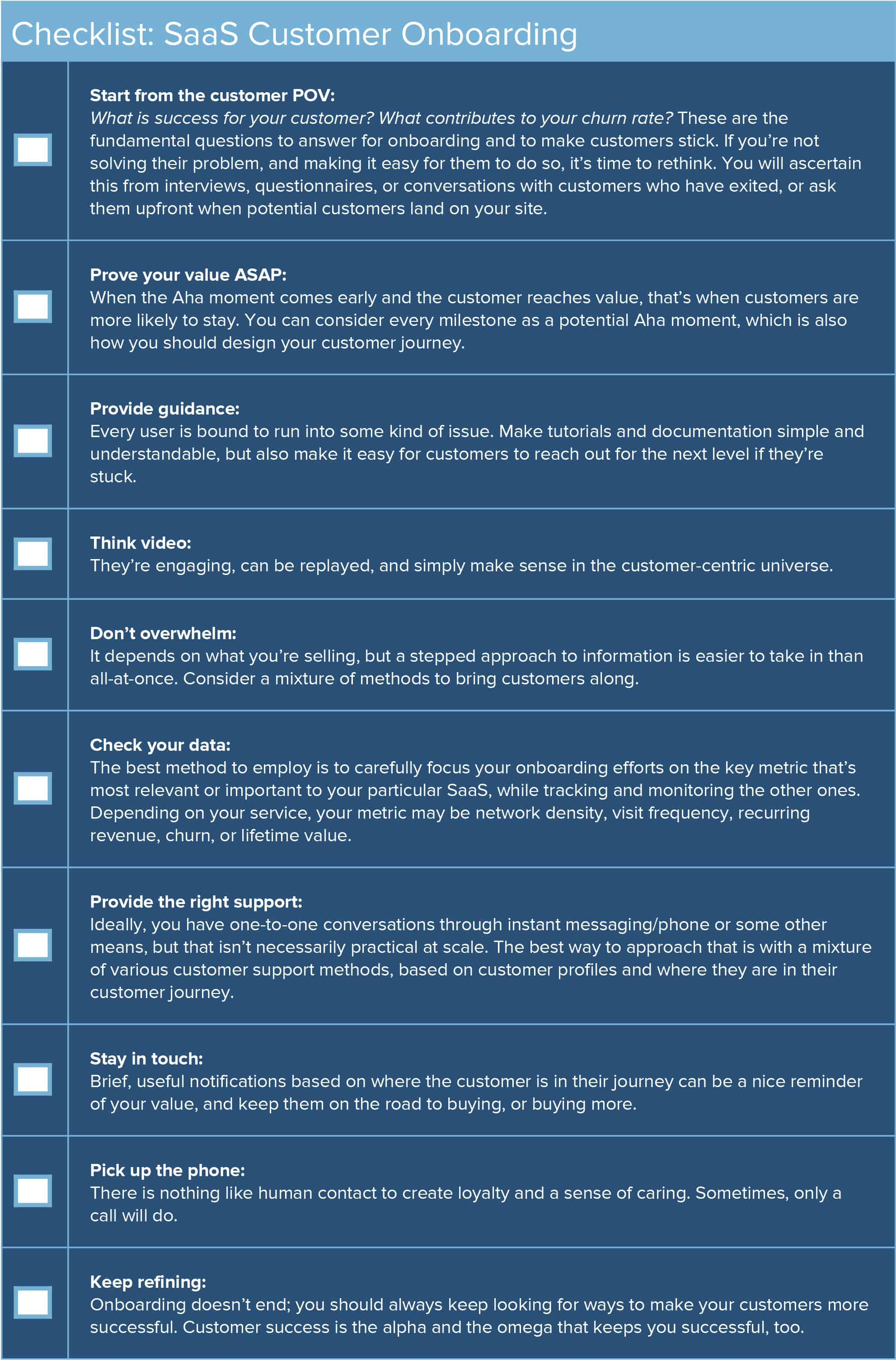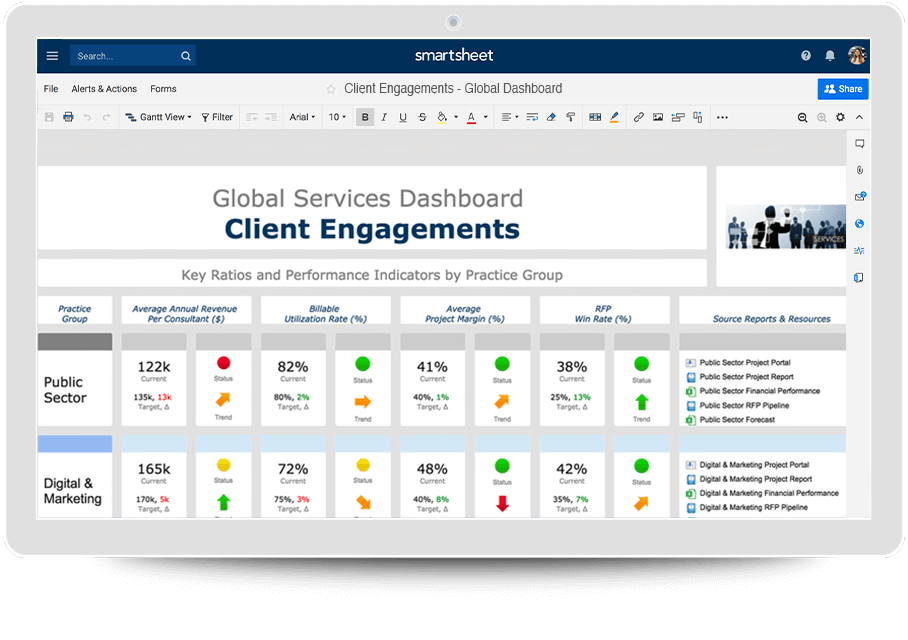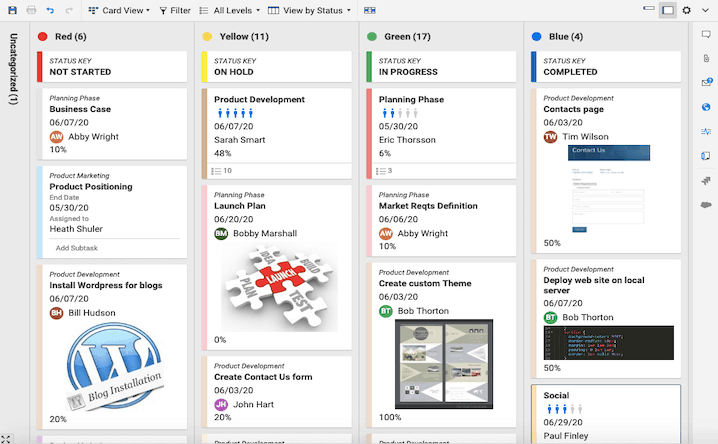The Customer Onboarding Process
Simply stated, customer onboarding is the process organizations use to take on new clients. It’s the way a company explains how their product or service works, the value of their solution, and ways you work with customers. An intrinsic component of excellent customer service, onboarding is the first step in the customer journey. If well-executed at every touchpoint from first contact to purchase and thereafter, it can be the beginning of a long and fruitful relationship. You can find great tips, checklists, and details about a client’s journey at The Definitive Guide to Client Onboarding.
The length of time it takes to completely onboard a client varies depending on your organization. If you’re a professional service that sells directly to a client through face-to-face interaction, the rule-of-thumb is that the process should last about 90 days. For Software-as-a-Service (Saas) companies, the process from first contact may take longer, particularly for businesses that offer 30 day free trials.
The Benefits of Customer Onboarding
Skillfully managing onboarding is good for your team and your customer. First and foremost it reduces churn by enhancing customer satisfaction as it increases revenue. Well-organized and documented customer onboarding also generates greater employee satisfaction because it makes interactions less stressful and more productive with more-effective ways to collaborate across functions and levels for practical gains throughout the organization.
Meet the Customer Onboarding Pros
The customer is king, and the latest customer-centric trend is providing ever-greater personalization. Creating a positive customer service experience before and after the sale is what makes brands successfully stand out from competitors. To learn how to develop a process using advanced customer onboarding strategies, we had three pros weigh in on the topic:
Sacha Ferrandi is the Founder of Source Capital Funding, Inc. and Texas Hard Money. In their twelfth year of service, the San Diego-based companies have a team of experts in real estate finance operating in Texas, Minnesota, California, and Arizona.
Tabitha Jean Naylor is the Founder of Successful Startup 101, a digital magazine that provides answers to today's most pertinent questions facing startup founders, and the Owner of TabithaNaylor.com, a marketing firm for startups and small businesses.
Angelique Pivoine is the Owner of Good Thinking Agency, a full-service marketing/PR agency offering a range of services from branding strategy to media outreach to inbound marketing services. Pivoine is a quoted expert on MSN, HuffingtonPost, NFIB, and numerous other media outlets.
One of the interesting things that came up in our conversations with the experts was that while there are many do’s to make new customers feel welcomed and supported, knowing about and avoiding the don’ts can be equally as important.
All three of our experts agreed that one of the most difficult and most necessary aspects of onboarding is simply knowing when it’s time to let go of a customer. It’s better to take the understanding you’ve gained and focus on retaining customers who value your product and service, and not create ill-will by holding on to dissatisfied customers who tend to air their grievances in online forums. Take the time to thank them for their business, and be sure to conduct an exit survey.
Customer Onboarding Checklist of Mistakes to Avoid
In an ever-more competitive marketplace for just about any product or service, it takes a lot of time, effort, and money to bring in new customers, so the last thing you want to do is turn off hard-won relationships.
A study by PowerswaterhouseCooper LLP found that most efforts to prevent customer churn fall short because they come too late in the buyer journey, and that it’s more profitable to understand why customers leave and then shift your model based on real data as fast as you can. Keep churn at bay by starting early and being armed with the information and willingness to be flexible in the way you work with customers.
Here’s are don’ts from our experts to consider as you design your own customized onboarding process:
Now that we’ve looked at how less-than-optimal onboarding can result in failure to retain clients with, let’s move on to the positive actions you can take.
Underutilized Customer Onboarding Best Practices and Strategies
The customer/user experience is essential a to a successful business, so it’s imperative that you use everything in your arsenal to understand what your customer needs, wants, and how to simplify their journey to buying (and more buying). According to the Harvard Business Review, the average American business loses 50 percent of its customers every five years. The reason: Two-thirds of respondents said they received inadequate customer care. In the same study, 91 percent of small businesses said that they do nothing to retain their existing clients. That’s not the way to win in competitive times. Our experts gave us their tried and true best practices tips to help you start or refine your own customer onboarding process.
Customer Onboarding Best Practices From The Experts
Source Capital Funding’s Ferrandi said, “We take great pride in customer service and believe in being open, direct and transparent with all of our clients. Solid communication is paramount to a successful transaction.” He offered a wealth of suggestions he’s used for onboarding that he’s learned in the last twelve years:
- Use your first meeting to create a custom checklist “Every client and industry is different and it is important to create a checklist for each new client after an initial exploratory meeting. Consider this meeting as a massive Q&A where the extent of the client’s knowledge on your system is revealed. Sometimes your clients will have a strong understanding of how your system works and sometimes they will have very little experience. Do not waste time working on a checklist until after you carry out this exploratory meeting.”
- Take it personally “It’s the simple things you find out interacting with customers during the ongoing process that can make all the difference to their success and yours. A great real-life example is a project we had with a client working on a property in Palm Springs. Our initial onboarding meeting let us know that the client needed our services in less than a week. Because of this meeting, we were able to expedite the entire onboarding process and put together a full checklist and schedule of our clients' needs. We were able to work around our clients schedule and get the project completed on time. Without this initial onboarding meeting, we would not have been able to acquire all of the necessary information and stakeholders' schedules so quickly.”
- Be honest “The biggest item people forget to put on their checklists is the process of overcoming roadblocks or issues with the service or product. There is always a point person to reach out to, but too often people forget to explain how these pain-points can be relieved because they do not want to admit that mistakes sometimes occur. Being honest and open is the best way to start any business relationship.”
- Avoid overload “The most important strategy is to avoid providing your client with information that they are responsible for reading and understanding without your help. Too often do we see extremely detailed and well put together process documentation that goes to waste because a client does not read it and comes to a meeting asking how to accomplish certain things. We love process documentation at Source Capital Funding, but be sure to include it as part of the in-meeting onboarding process or as a web-based tutorial system. Present everything ahead of time and then give a detailed report that the client can refer to if he or she has any questions.”
- Make it easy and casual “One of the best ways to ensure a smooth onboarding process is to invite the client for a lunch meeting and go over any necessary documents in-person. Providing food is a great way to make the client feel like he or she is not wasting time in the middle of the work day and also allows for more stakeholders to be present without the meeting feeling too formal. Be sure to have a set agenda for the meeting with a clear leader or else the lunch portion of the meeting may overshadow the onboarding process.”
- Be available when it makes sense for customers “Much like professors have ‘office hours’ for their students, a great onboarding tactic is to provide available times that your client can call on you with any questions or concerns. Not only does this eliminate the waiting period between emails, it also shows the client how dedicated you are to their needs. Your team should be available to respond to emails and calls as needed. This tip is also an excellent way for teams with several clients to organize client time. Furthermore, if your process has a lot of paperwork or materials that the client needs to read, these office hours will reduce the need for long in-person meetings.”
Successful Startup 101’s Naylor had two valuable best practice suggestions for startups that she thinks are fundamental to smooth onboarding:
- Keep it short and simple “It’s important that my onboarding checklist includes everything I need to ensure a fruitful working relationship, but that it is also brief enough that the process won’t stretch my client’s patience.”
- Feel the churn “Churn occurs when you lose customers or clients because they are dissatisfied with your products or services. So it’s really important that you first understand the major causes of churn (wrong features, not enough features, high prices, difficulty in using product or service, lack of value), and build safeguards into your onboarding strategy to reduce churn.”
Good Thinking Agency’s Pivoine shared her own customer onboarding checklist/questionnaire that she uses in her PR/marketing practice start-up meetings, including follow-up actions:
Underutilized Customer Onboarding Best Practices and Strategies
Customer Onboarding Welcome Email Template
One of the ways most companies stay in touch with customers is via email. Here’s a template that can work for most products and services to welcome newly onboarded customers:
Greeting:
Make it casual and personalize with the first name.
Paragraph 1:
Welcome and thank the customer for joining you.
Describe your company, your mission, and how you help the customer succeed.
Paragraph 2:
Describe what the customer should do next to set them up for success.
Provide a useful tip.
Link them to a landing/getting started page with a CTA/download.
Paragraph 3:
Offer to answer questions or provide help.
Provide a link or explain the best method to do so.
Closing:
Make it friendly, brief, and personal.
Add contact or team name
Once you’ve gotten off to a good start, keep the communication going by getting feedback to help you improve your relationships and onboarding process.
Advanced SaaS Customer Onboarding Checklist and Strategies
When we asked Naylor about her tips regarding SaaS onboarding, she noted, “An SaaS onboarding strategy checklist is vital to the success of your business. One of the biggest mistakes SaaS companies make is that they don’t account for churn when they develop their onboarding checklist.”
Naylor went on to make two more points:
- Getting on the same page “It’s really important that you establish the parameters for success. What does that mean? It simply means that you communicate with your client or customer what services you are going to provide, how you will provide them and when you will provide them. By clearly defining your goals, it’s much easier to achieve success, and by the way, if your goals aren’t in sync with your client’s goals that will become apparent at the onboarding process, giving you time to get on the same page.”
- The power of the free trial “There’s something that many companies forget to put on their checklist and that is especially true for SaaS companies: free trials. Think about it. You’re selling software, which is a product that customers need to ‘test-drive’ for a few days before they are comfortable. So by offering a free trial, whether it’s for three, seven or 30 days, you are giving customers tremendous value, because if your product is up to snuff, that trial is really just seven free days of value that they will want to convert into months and years of value.”
Based on her experience with SaaS clients, Pivoine said that there are two things she makes sure to do when onboarding SaaS customers:
- Set expectations “Don't say your software will fix all of their issues unless it really can. You do not want to set the expectation too high here. Remember, onboarding is not sales! You're trying to have a realistic gauge on your client's needs and offer appropriate solutions.”
- Understand why customers are looking for a new product “Find out (in detail) why your client was unhappy with the previous software: the interface, the learning curve, the service support, etc. Write them all down, and don't forget to check in with your clients on these specific topics during user training. That will build their trust and confidence in you. Earn yourself some brownie points by having some examples ready of clients who had issues with your software and HOW you addressed and solved those issues.”
Based on all the input from all our experts, here are some ideas to consider for your own SaaS Onboarding Strategy:
Additionally, all of this customer interfacing also gives you the ability to collect a lot of data.
Customer Onboarding Tools and Software
How do you collect and prioritize customer data during the onboarding process so that it’s useful? Cloud-based tools and software are low-cost, flexible, and provide a way to manage and automate collaborative customer onboarding work.
Our experts noted that the use of key performance indicators (KPIs) are useful to measure your success and that of your customer. With the right tools you can use them to identify friction points and make repairs quickly, and most importantly share them with your team. KPIs for customer onboarding researched by Service Source include customer time to value, activation rate, adoption rate, product/feature utilization score, expansion bookings, net new bookings, and retention rate.
Using a KPI analytics dashboard can help you understand trends by making comparisons across time and multiple variables. Here’s an example of a customer engagement dashboard:
You can also use a customizable tool like Smartsheet to track and analyze what you’ve identified as customer needs for success:

Use online tools to document and track your onboarding process and share it with team members and review it for refinement as you check against KPIs
Highly-visual tools can be a good way to expedite collaboration within your team and with customers:
Drive ROI with Effective Customer Onboarding in Smartsheet
Empower your people to go above and beyond with a flexible platform designed to match the needs of your team — and adapt as those needs change.
The Smartsheet platform makes it easy to plan, capture, manage, and report on work from anywhere, helping your team be more effective and get more done. Report on key metrics and get real-time visibility into work as it happens with roll-up reports, dashboards, and automated workflows built to keep your team connected and informed.
When teams have clarity into the work getting done, there’s no telling how much more they can accomplish in the same amount of time. Try Smartsheet for free, today.







